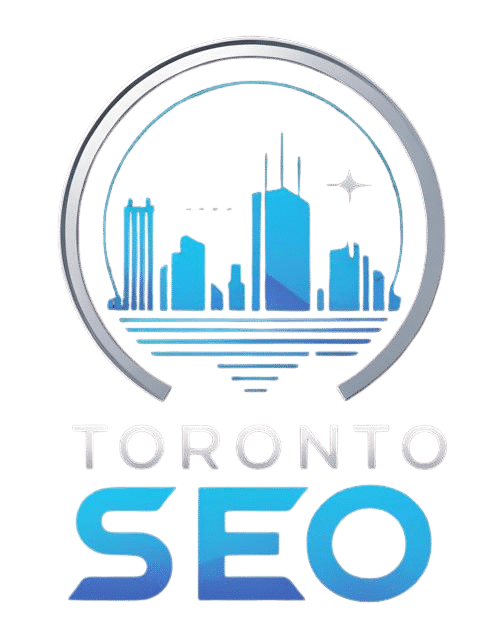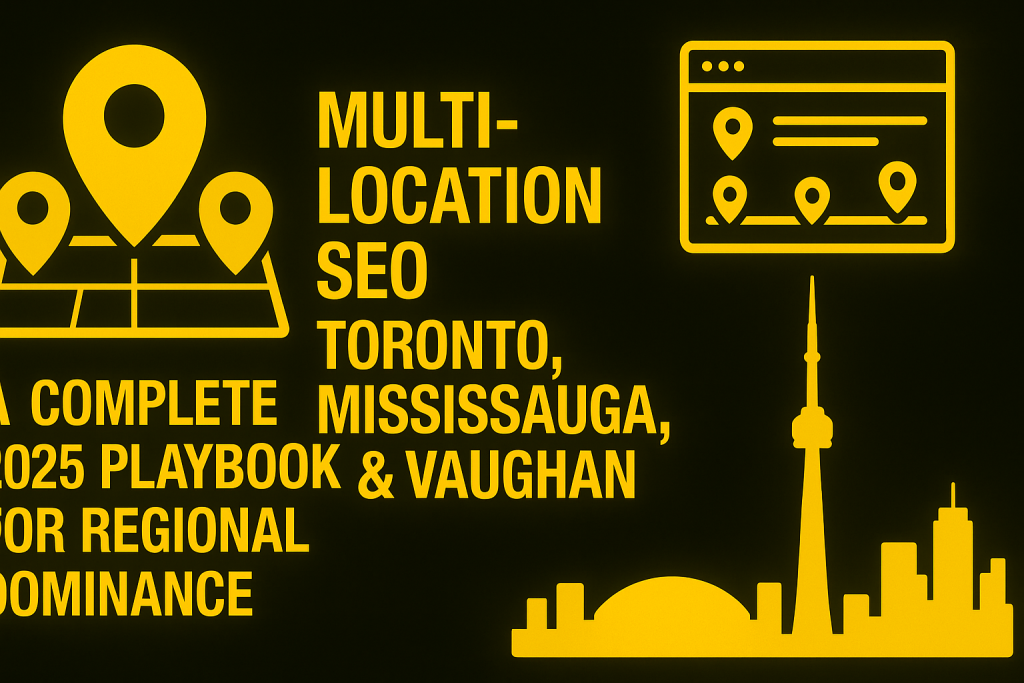Why Multi-Location SEO Matters More Than Ever in 2025
In today’s competitive digital marketplace, multi-location SEO has evolved from a niche strategy into an essential growth framework for brands operating across multiple cities. For businesses in Toronto, Mississauga, and Vaughan, the challenge is not only to rank locally but to dominate regionally — capturing visibility across the entire Greater Toronto Area (GTA).
With Google’s AI-driven search algorithms and SGE (Search Generative Experience) now shaping how users discover local businesses, having a one-size-fits-all approach simply doesn’t work anymore. Each city has its own competitive dynamics, search intent, and customer behavior — requiring a localized SEO strategy that scales intelligently.
This guide breaks down how to build and optimize a multi-location SEO strategy that helps your business thrive across these three powerful markets.
Understanding Multi-Location SEO in the GTA
What Is Multi-Location SEO?
Multi-location SEO is the practice of optimizing your website, Google Business Profiles, and content strategy for multiple geographic areas. It allows your business to appear in local searches such as:
“Best HVAC company in Mississauga”
“Digital marketing agency Toronto downtown”
“Roofing contractors Vaughan near me”
Rather than competing for a single local keyword, your goal is to build authority across all target cities, while maintaining a consistent brand presence and localized relevance.
Why Toronto, Mississauga, and Vaughan Are High-Value SEO Hubs
Each of these cities represents a different SEO opportunity:
Toronto: Canada’s commercial capital, dominated by competitive industries like tech, law, and finance.
Mississauga: Home to large industrial and logistics zones, making it ideal for service-based and B2B companies.
Vaughan: A rapidly growing suburban hub with high residential development, perfect for home services and local retail.
Optimizing for all three ensures your brand captures the full buyer journey — from research to conversion — across the GTA.
Building a Multi-Location SEO Framework
1. Create Unique Location Pages
Each city must have its own optimized landing page tailored to local audiences. For example:
/seo-toronto//seo-mississauga//seo-vaughan/
These pages should include:
City-specific headlines and descriptions
Local testimonials and case studies
Embedded Google Maps for each branch
Optimized meta titles and descriptions
Schema markup for LocalBusiness
See Rank Location Pages Toronto and GTA for a full implementation guide.

2. Optimize Your Google Business Profiles (GBP)
Each branch must have its own verified and optimized GBP. Ensure:
NAP (Name, Address, Phone) consistency
City-focused keywords in the business description
Local photos and service area coverage
Regular posting using location tags
For insights, read Google Business Profile Toronto Guide.
Pro Tip: Use UTM parameters in your GBP URLs to track how much traffic each location generates.
3. Build Localized Content Silos
Content silos help Google understand the relevance of your business for each region. Create pillar pages for each city and link them to related blog posts or case studies.
For example:
Pillar Page: “SEO Services in Toronto”
Supporting Post: Understanding Google’s Latest Algorithm Update
Supporting Post: “How Toronto SEO Agencies Build High Authority Backlinks”
This structure boosts topical authority, helping each page rank faster.
4. Implement Consistent On-Page Optimization
Every city page must have its own:
Unique H1, H2, and meta data
City-specific keywords
Internal links to blog posts like Content Optimization: Boosting Engagement and Rankings
Clear CTAs like “Book a Free SEO Consultation in Vaughan”
Never duplicate content across city pages — it will hurt your rankings. Instead, adapt messaging to reflect local nuances.
5. Use Structured Data and Schema
Implement LocalBusiness, Service, and Review schema for each branch. This helps Google understand which locations you serve and display rich snippets such as ratings, operating hours, and addresses.
For example:
{
"@context": "https://schema.org",
"@type": "LocalBusiness",
"name": "Toronto SEO Agency - Mississauga",
"address": {
"@type": "PostalAddress",
"streetAddress": "123 Lakeshore Rd",
"addressLocality": "Mississauga",
"addressRegion": "ON",
"postalCode": "L5E 1A2"
}
}
Link-Building for Multi-Location SEO
1. Acquire City-Specific Backlinks
Each location should have backlinks from local directories, chambers of commerce, and industry blogs.
Submit your business to:
2. Use Local Citations
Citations still matter for consistency and trust signals. Learn more in Why Citation Building Still Matters for Toronto Local Rankings.
Tools like BrightLocal or Whitespark can streamline citation management across all branches.
Advanced Multi-Location SEO Strategies
Leverage AI-Powered Local Insights
TorontoSEO.com has highlighted in Top SEO Agencies in Toronto Using AI that machine learning is revolutionizing keyword targeting. AI tools can:
Predict which neighborhoods convert better
Cluster local search terms by intent
Optimize content personalization by city
Utilize Geo-Targeted PPC to Support SEO
Pair organic SEO with Google Ads for high-intent city keywords. This ensures brand visibility while new pages build organic traction. Refer to SEO vs Google Ads in Toronto for a comparative ROI breakdown.
Focus on Review Management and Reputation
Consistent five-star reviews across all GBPs influence both local rankings and click-through rates. Encourage satisfied customers in each city to leave feedback mentioning location-specific experiences.
Tracking and Analytics for Multi-Location SEO
Set Up Multi-Domain Tracking
Use Google Analytics 4 and Google Search Console property filters to monitor each branch separately. Track:
Organic traffic per city
Clicks and impressions by region
Conversion data tied to GBP URLs
For advanced tracking, see How to Track SEO Performance with Analytics.
Common Multi-Location SEO Mistakes to Avoid
Using duplicate content across city pages
Neglecting localized link-building
Ignoring NAP inconsistencies
Not optimizing GBP categories
Failing to assign city-specific CTAs
Avoid these pitfalls to prevent ranking drops and maintain consistent visibility across all regions.
Future of Multi-Location SEO in 2025 and Beyond
Google’s ongoing evolution towards entity-based understanding means businesses must focus on brand consistency and local trust. AI-driven SEO and predictive algorithms will continue to shape visibility.
As explored in The Future of SEO in Toronto, success will depend on integrating data-driven insights, maintaining brand authority, and continually optimizing for local user intent.
Conclusion: Own Every City in the GTA
For Toronto, Mississauga, and Vaughan businesses, multi-location SEO is the foundation for regional dominance. By combining localized content, structured data, AI insights, and strong reputation management, you can position your brand as the top choice across every market in the GTA.
If you’re ready to scale your visibility and outperform local competitors, contact the experts at TorontoSEO.com today for a customized multi-location SEO strategy built to deliver measurable growth.
FAQs About Multi-Location SEO
1. How long does it take to see results from multi-location SEO?
Typically, results start appearing within 3–6 months depending on the competition level and optimization depth of each city page.
2. Do I need a separate website for each location?
No. One domain with optimized location pages and structured data is better for consolidating authority.
3. What’s the best way to manage multiple Google Business Profiles?
Use Google Business Manager or third-party tools like BrightLocal for centralized management.
4. How do I handle duplicate content across locations?
Avoid copy-pasting — rewrite city pages with unique examples, reviews, and localized CTAs.
5. Is paid advertising still important if I have strong SEO?
Yes. PPC campaigns can complement SEO by driving immediate leads while your organic rankings strengthen.


